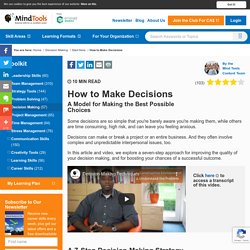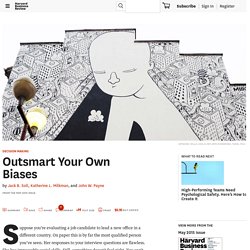

Cause and Effect Analysis (Fishbone Diagrams) - from MindTools.com. Root Cause Analysis - Problem Solving From MindTools.com. Tracing a Problem to its Origins Learn how to use Root Cause Analysis to fix problems more easily.

In medicine, it's easy to understand the difference between treating the symptoms and curing the condition. A broken wrist, for example, really hurts! But painkillers will only take away the symptoms; you'll need a different treatment to help your bones heal properly. But what do you do when you have a problem at work? However, if you look deeper to figure out what's causing the problem, you can fix the underlying systems and processes so that it goes away for good. Root Cause Analysis (RCA) is a popular and often-used technique that helps people answer the question of why the problem occurred in the first place. Determine what happened. RCA assumes that systems and events are interrelated. You'll usually find three basic types of causes: Physical causes – Tangible, material items failed in some way (for example, a car's brakes stopped working). Make Sure You’re Solving the Right Problem. It may be obvious that you can’t solve a problem that’s not well defined, but many people neglect this detail.

Next time you think you’re ready to go into problem-solving mode, consider the following: Establish the basic need for a solution. Why does the problem need solving? The Problem-Definition Process - Problem-Solving Tools From MindTools.com. Developing the Right Solution © iStockphotoklaravlas.

How to Make Decisions - Decision Making Tools From MindTools.com. Some decisions are so simple that you're barely aware you're making them, while others are time consuming, high risk, and can leave you feeling anxious.

Decisions can make or break a project or an entire business. And they often involve complex and unpredictable interpersonal issues, too. In this article and video, we explore a seven-step approach for improving the quality of your decision making, and for boosting your chances of a successful outcome. The Effective Decision. Effective executives do not make a great many decisions.

They concentrate on what is important. They try to make the few important decisions on the highest level of conceptual understanding. They try to find the constants in a situation, to think through what is strategic and generic rather than to “solve problems.” They are, therefore, not overly impressed by speed in decision making; rather, they consider virtuosity in manipulating a great many variables a symptom of sloppy thinking. They want to know what the decision is all about and what the underlying realities are which it has to satisfy.
Effective executives know when a decision has to be based on principle and when it should be made pragmatically, on the merits of the case. Sequential Steps The elements do not by themselves “make” the decisions. Leaders as Decision Architects. All employees, from CEOs to frontline workers, commit preventable mistakes: We underestimate how long it will take to finish a task, overlook or ignore information that reveals a flaw in our planning, or fail to take advantage of company benefits that are in our best interests.

It’s extraordinarily difficult to rewire the human brain to undo the patterns that lead to such mistakes. But there is another approach: Alter the environment in which decisions are made so that people are more likely to make choices that lead to good outcomes. Leaders can do this by acting as architects. Drawing on our extensive research in the consulting, software, entertainment, health care, pharmaceutical, manufacturing, banking, retail, and food industries and on the basic principles of behavioral economics, we have developed an approach for structuring work to encourage good decision making. Outsmart Your Own Biases.
Executive Summary When making decisions, we all rely too heavily on intuition and use flawed reasoning sometimes.

But it’s possible to fight these pernicious sources of bias by learning to spot them and using the techniques presented in this article, gleaned from the latest research. They’ll open up your thinking about possible outcomes, objectives, and options and lead to better choices. To broaden your perspective on the future, the authors suggest, you can use proven tactics for improving the accuracy of estimates and preparing for contingencies.
You’ll think more expansively about your objectives if you come up with many possibilities before deciding what’s most important, get input from others, and then carefully examine one goal at a time. Strong emotional attachments or investments make cognitive biases even harder to overcome. HBR Reprint R1505D. How can decision making be improved? Decision Making Techniques and Skills from MindTools.com. Free Workbook Offer!

Find Out More JoinBefore Mar 22 FREE Toolkit Offer Get our new Take Control of Your Time Toolkit FREE when you join the Mind Tools Club before midnight, March 22. Loading... Got it! We use cookies to give you the best experience of our website. Cookie Consent plugin for the EU cookie law Get the Free Newsletter Get the Free Newsletter Learn new career skills every week, and get our Personal Development Plan Workbook FREE when you subscribe. Privacy Policy Browse Tools by Category Start Here (2) Before You Make That Big Decision... (HBR Bestseller) This pricing is for PDFs that are purchased and downloaded from our website and printed copies that ship from our warehouse to your requested shipping location. 1-4 = $8.95 each 5-10 = $8.75 each 11-49 = $8.50 each 50-499 = $8.25 each 500+ = $8.00 each.

Avoiding Psychological Bias in Decision Making - From MindTools.com. How to Make Objective Decisions © iStockphotokemie Are you making a balanced judgement, or do you have confirmation bias?

Imagine that you're researching a potential product. You think that the market is growing, and, as part of your research, you find information that supports this belief.